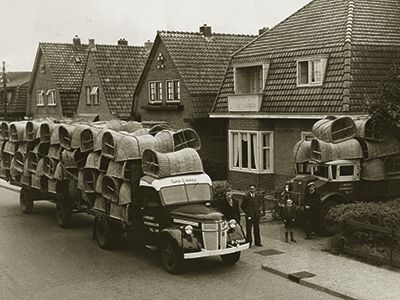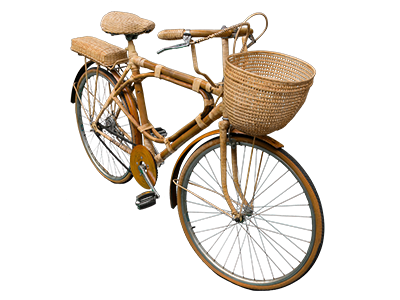
The National Braid Museum in Noordwolde recounts a remarkable tale of how people forged a livelihood by harnessing the natural resources their surroundings had to offer.
How did Noordwolde develop into the Braiding Village of the Netherlands? How was this related to the harsh living conditions in the peatlands? What role did the Colonies of Benevolence play? And why did the rattan industry collapse at the close of the 20th century? You will discover the answers to these questions at the National Braid Museum.
In the second half of the previous century, rattan chairs graced many living rooms, nearly all crafted in Noordwolde. In the peak years, more than 250,000 chairs a year were made across some 80 small and larger factories; all handmade. Almost the entire village lived off this craft. Hence, Noordwolde proudly declares itself the Braiding Village of the Netherlands. All these chairs were transported by train throughout north-western Europe. The museum now features the old locomotive that once hauled wagons laden with rattan chairs.
Step into the museum to immerse yourself in the ambience of yesteryears within the former National Rattan Weaving School, where the echoes of students’ clogs once reverberated through the corridors. After all, this national monument is the very site where the craft was honed.
The museum ensures full accessibility for visitors with walkers or wheelchairs, including an accessible toilet. Manauplein, adjacent to the museum, typically offers ample parking, all free of charge, ensuring convenience without the need for lengthy walks.
The texts of the audio tour are available in English.
Das Nationale Flechtmuseum in Noordwolde erzählt eine außergewöhnliche Geschichte über die Menschen, die sich mit den natürlichen Ressourcen, die ihnen die Umgebung bot, eine Existenzgrundlage geschaffen haben.
Wie konnte sich Noordwolde zum Flechtdorf der Niederlande entwickeln? Wie stand dies im Zusammenhang mit den harten Lebensbedingungen in den Torfgebieten? Welchen Einfluss übten die Kolonien der Wohltätigkeit aus? Warum erlebte die Rattanindustrie Ende des 20. Jahrhunderts einen Niedergang? Die Antworten auf diese Fragen finden Sie im Nationalen Flechtmuseum.
In der zweiten Hälfte des letzten Jahrhunderts standen in vielen Wohnzimmern Rattanstühle. Diese wurden fast alle in Noordwolde hergestellt. In der Blütezeit wurden in rund 80 kleinen und größeren Fabriken mehr als 250.000 Stühle pro Jahr gefertigt, alle in Handarbeit. Fast das gesamte Dorf bestritt seinen Lebensunterhalt mit diesem Handwerk. Noordwolde nennt sich daher mit Stolz das Flechtdorf der Niederlande. Alle diese Stühle wurden mit dem Zug durch Nordwesteuropa befördert. Beim Museum steht die alte Lokomotive, die die Waggons voller Rattanstühle transportierte.
Das Museum gewährt Ihnen einen Einblick in die Atmosphäre vergangener Zeiten in der ehemaligen Staatlichen Schilfrohrflechtschule, wo die Holzschuhe der Schüler die Flure mit ihrem Klappern erfüllten. Dieses Reichsmonument ist nämlich der Ort, an dem sie ihr Handwerk gelernt haben.
Das Museum ist für Personen mit Rollatoren oder Rollstühlen vollständig zugänglich. Es gibt auch eine Behindertentoilette. Auf dem Manauplein, neben dem Museum, finden Sie fast immer einen freien Parkplatz. Sie müssen also nicht weit laufen und können kostenlos parken.
Die Texte des Audioguides können auch auf Deutsch gelesen werden.
诺德沃尔德的国家编织博物馆讲述了一个关于人们如何利用周围环境提供的自然资源来建立生计的特别故事。
为什么诺德沃尔德会成为荷兰的编织之乡? 这与沼泽地区的恶劣生活条件有何关联? 当时的慈善殖民地对此有何影响? 为什么藤编工业在20世纪末期走向了衰落? 您可以在国家编织博物馆找到这些问题的答案。
上个世纪下半叶,许多客厅里都摆放着藤椅。 几乎所有这些藤椅都是在诺德沃尔德制造的。 在巅峰时期,大约有80家大小不一的工厂每年生产超过25万把椅子,全部都是手工制作。 几乎整个村庄都以此手艺为生。 因此,诺德沃尔德自豪地称自己为荷兰的编织之乡。 所有这些椅子都通过火车运往整个西北欧。 在博物馆旁边停着一个旧火车头,它曾经拉着满载藤椅的火车厢行驶。
博物馆让您在昔日的国立藤编学校中感受当时的氛围,在那里,学生们的木鞋曾经在走廊上吱吱作响。 这处国家古迹正是他们当时学习手艺的地方。
博物馆也欢迎使用助行器或坐轮椅的访客。 此外,博物馆还设有残疾人卫生间。 在博物馆旁边的Manauplein小广场几乎总是有空位。 因此,您无需走很远,停车也是免费的。
语音导览的文本支持多种语言 中文。





